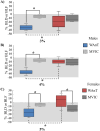The effects of sex and load on quantifying the bilateral force deficit during an upper body Wingate test
- PMID: 39830976
- PMCID: PMC11739103
- DOI: 10.3389/fspor.2024.1446909
The effects of sex and load on quantifying the bilateral force deficit during an upper body Wingate test
Abstract
Introduction: The bilateral deficit (BLD) is a reduction in the amount of force during a bilateral task vs. the total force from the unilateral limbs performing the same task. We quantified the BLD during an upper body Wingate Anaerobic Test (WAnT) and evaluated the influence of sex and load on the BLD in force.
Methods: Eighteen participants performed maximum handgrip strength, voluntary isometric contractions (MVIC), and three 30s WAnTs. In each session they completed the tasks with the dominant-arm, non-dominant arm and with both arms, randomly. WAnT intensities were 3, 4, and 5% body weight (BW). Instantaneous force data was used to calculate the BLD.
Results: Males showed greater (p < .001) BLD of force at 3, 4, and 5% BW than females by -17, -27.6 and -36%, respectively and had a greater (p < .001) BLD of force than females throughout time points 1-10 s, 11-20 s, and 21-30 s by -16, -29 and -35%, respectively. Females showed a difference (p < .001) in BLD of force between loads (-19% at 3%, -10% at 4% and +7% at 5%). Males had an increase (p < .001) in BLD of force from the beginning to the end of the WAnT starting with -18% (1-10 s), -38% (11-20 s) and -40% (21-30 s). WAnT had the highest BLD, followed by MVIC and grip strength.
Discussion: BLD in force is present during WAnTs and the sex-load interaction is important for determining this BLD during this maximal cycling test. Thus, when developing training or rehabilitation programs related to BLD in force, sex, load and exercise type should be taken into consideration.
Keywords: bilateral deficit; cycling; fatigue; upper body; velocity.
© 2025 Antolinez, Edwards, Holmes and Button.
Conflict of interest statement
The authors declare that the research was conducted in the absence of any commercial or financial relationships that could be construed as a potential conflict of interest.
Figures



Similar articles
-
The Effects of Load, Crank Position, and Sex on the Biomechanics and Performance during an Upper Body Wingate Anaerobic Test.Med Sci Sports Exerc. 2024 Aug 1;56(8):1422-1436. doi: 10.1249/MSS.0000000000003436. Epub 2024 Mar 23. Med Sci Sports Exerc. 2024. PMID: 38537272
-
Bilateral deficit in explosive force production is not caused by changes in agonist neural drive.PLoS One. 2013;8(3):e57549. doi: 10.1371/journal.pone.0057549. Epub 2013 Mar 5. PLoS One. 2013. PMID: 23472091 Free PMC article.
-
Mitigating the bilateral deficit: reducing neural deficits through residual force enhancement and activation reduction.Eur J Appl Physiol. 2018 Sep;118(9):1911-1919. doi: 10.1007/s00421-018-3924-x. Epub 2018 Jun 29. Eur J Appl Physiol. 2018. PMID: 29959517
-
Bilateral and unilateral contractions: possible differences in maximal voluntary force.Can J Appl Physiol. 2001 Feb;26(1):12-33. doi: 10.1139/h01-002. Can J Appl Physiol. 2001. PMID: 11173667 Review. English, French.
-
Standard anaerobic exercise tests.Sports Med. 1987 Jul-Aug;4(4):268-89. doi: 10.2165/00007256-198704040-00004. Sports Med. 1987. PMID: 3306867 Review.
References
LinkOut - more resources
Full Text Sources

